Related Research Articles

The Caucasus Mountains is a mountain range at the intersection of Europe and Asia. Stretching between the Black Sea and the Caspian Sea, it is surrounded by the Caucasus region and is home to Mount Elbrus, the highest peak in Europe at 5,642 metres (18,510 ft) above sea level.

Mount Kazbegi or Mount Kazbek is a dormant stratovolcano and one of the major mountains of the Caucasus, located on the border of Georgia's Kazbegi District.

The Greater Caucasus is the major mountain range of the Caucasus Mountains.
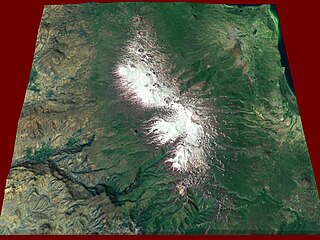
Gegham mountains, Armenian: Գեղամա լեռնաշղթա are a range of mountains in Armenia. The range is a tableland-type watershed basin of Sevan Lake from east, inflows of rivers Araks and Hrazdan from north and west, Azat and Vedi rivers from south-west and Arpachai river from south. The average elevation of the Gegham mountain range is near 2500m. The range is of volcanic origin including many extinct volcanoes. The range is 70 km length and 48 km width, and stretch between Lake Sevan and the Ararat plain. The highest peak of the Gegham mountains is the Azhdahak, at 3597m. They are formed by a volcanic field, containing Pleistocene-to-Holocene lava domes and cinder cones. The highland reaches a height of 1800–2000m up to 3000m in the dividing ridge.

The Volcanic Seven Summits are the highest volcanoes on each of the seven continents, just as the Seven Summits are the highest peaks on each of the seven continents. Summiting all seven is regarded as a mountaineering challenge, first postulated as such in 1999.

The Keli (Qeli) Highland is a volcanic field in Georgia on the western side of the Jvari Pass south to the Greater Caucasus range. More than thirty volcanic edifices on an area of 20x30km2 make up this volcanic field, which consists mostly of monogenetic volcanic structures. The lavas are rhyolites, trachyandesites and andesites.

The Andagua volcanic field is a volcanic field in southern Peru which includes a number of cinder cones, lava domes and lava flows which have filled the Andagua Valley. The volcanic field is part of a larger volcanic province that clusters around the Colca River and is mostly of Pleistocene age, although the Andagua sector also features volcanic cones with historical activity, with the last eruption about 370 years ago. Eruptions were mostly effusive, generating lava flows, cones and small eruption columns. Future eruptions are possible, and there is ongoing fumarolic activity. Volcanic activity in the field has flooded the Andahua valley with lava flows, damming local watersheds in the Laguna de Chachas, Laguna Mamacocha and Laguna Pumajallo lakes and burying the course of the Andagua River. The Andahua valley segment of the larger volcanic province was declared a geopark in 2015.
Crater Basalt volcanic field is a volcanic field in Argentina in the Chubut province.

The Udokan Plateau is a volcanic field in Transbaikalia, Russia. It covers a surface area of 3,000 square kilometres (1,200 sq mi) northeast of Lake Baikal in North Asia. Volcanism in the Udokan Plateau included both basaltic lava flows and later individual volcanic cones. Volcanism commenced in the Miocene and continued on into the Holocene.

Jom-Bolok, also known as Volcano Valley and East Sayan Volcanic Field, is a volcanic field in Russia, 200 kilometres (120 mi) west of Lake Baikal. It is part of the Baikal rift zone which is also responsible for volcanism elsewhere around Lake Baikal. The volcanic activity has generated long lava flows and cinder cones. One of the lava flows is 70 kilometres (43 mi) long and has a volume of 7.9 cubic kilometres (1.9 cu mi).
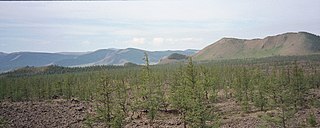
Taryatu-Chulutu is a volcanic field in Mongolia. It is part of a volcanic area in Central Asia in the Hangai range that may be linked to the rifting of the Lake Baikal Rift. The field itself is located within the valleys of the Chuluut and Suman rivers. Volcanic activity occurred in the Miocene, Pliocene, Pleistocene and Holocene. The Khorgo cinder cone erupted during the Holocene and lava flows from it formed a lava dam generating Terkhiin Tsagaan Nuur lake.

Koh-i-Sultan is a volcano in Balochistan, Pakistan. It is part of the tectonic belt formed by the collision of India and Asia: specifically, a segment influenced by the subduction of the Arabian plate beneath the Asian plate and forming a volcanic arc which includes the Bazman and Taftan volcanoes in Iran. The volcano consists of three main cones, with heavily eroded craters running west-northwest and surrounded by a number of subsidiary volcanic centres. Its summit is 2,334 metres (7,657 ft) high, and the crater associated with the Miri cone has a smaller crater inside.

Azas Plateau is a volcanic field in Russia. It is also known as East Tuva Plateau, Khamsara-Biykhem Plateau and Northeast Tuva Plateau. It covers a surface area of 2,000 square kilometres (770 sq mi) west of Lake Baikal. Volcanic activity in the area also occurred at the Oka Plateau and the Jom-Bolok volcanic field.

Kunlun Volcanic Group, also known as Ashikule, is a volcanic field in northwestern Tibet. Eight other volcanic fields are also in the area. The field is within a basin that also contains three lakes.
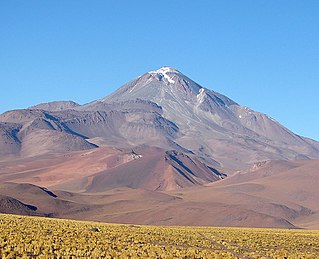
Llullaillaco is a dormant stratovolcano at the border of Argentina and Chile. It lies in the Puna de Atacama, a region of tall volcanic peaks on a high plateau close to the Atacama Desert, one of the driest places in the world. It is the second highest active volcano in the world after Ojos del Salado.

Ciomadul is a volcano in Romania, and is known as Csomád in Hungarian. It is in the Carpathians, close to the towns of Băile Tușnad and Bixad. It is part of a volcanic chain known as the Călimani (Kelemen) – Gurghiu (Görgényi) – Harghita (Hargita) chain and lies at its southeastern end. Ciomadul consists of several lava domes with two embedded explosion craters known as Mohos and St. Ana, the latter of which contains a crater lake, Lake Sfânta Ana. The dominant volcanic rock at Ciomadul is potassium-rich dacite.

Mount Erciyes, also known as Argaeus, is a volcano in Turkey. It is a large stratovolcano surrounded by many monogenetic vents and lava domes, and one maar. The bulk of the volcano is formed by lava flows of andesitic and dacitic composition. At some time in the past, part of the summit collapsed towards the east.
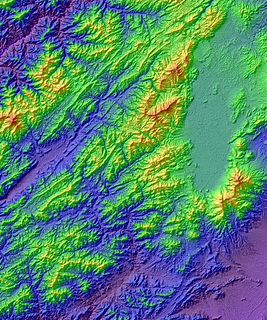
The Dacht-i-Navar Group is a volcanic field in Afghanistan. It consists of a group of lava domes and stratovolcanoes at the southern end of the Dacht-i-Navar depression and partly extend north of the same depression. They have been active during the Pliocene and Pleistocene.
Northern Tibet volcanic field is a volcanic field in China.
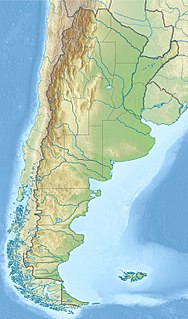
Pasto Ventura is an area in the Catamarca Province of Argentina. It features about 14 small Pleistocene volcanoes, mostly cinder cones with associated lava flows but also lava domes, tuff rings and two maars. The volcanoes are accompanied by pyroclastic deposits and their total volume reaches about 0.42 cubic kilometres (0.10 cu mi). Argon-argon dating has yielded ages ranging from 1.3 million years to about 270,000 years for volcanic rocks in the field.
References
- 1 2 3 4 Lebedev & Vashakidze 2014, p. 98.
- 1 2 Lebedev & Vashakidze 2014, p. 102.
- ↑ Lebedev & Vashakidze 2014, p. 99.
- ↑ Lebedev & Vashakidze 2014, p. 103.
Sources
- Lebedev, V. A.; Vashakidze, G. T. (16 May 2014). "The catalogue of Quaternary volcanoes of the Greater Caucasus based on geochronological, volcanological and isotope-geochemical data". Journal of Volcanology and Seismology. 8 (2): 93–107. doi:10.1134/S0742046314020043. S2CID 129619384.